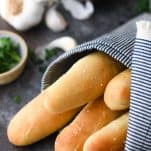Homemade Breadsticks
These homemade garlic breadsticks are light, fluffy, buttery, and just like Olive Garden's!
Servings 12 breadsticks
Calories 151kcal
Ingredients
- 3– 3 ½ cups bread flour (or sub with all-purpose flour)
- 1 ½ tablespoons granulated sugar
- 1 ½ teaspoons salt
- 1 ½ teaspoons instant “rapid rise” yeast
- 1 cup plus 2 tablespoons warm water (about 110° F – 115° F)
- 1 tablespoon canola oil
For Topping:
- 2 tablespoons butter, melted
- ½ teaspoon kosher salt
- ¼ teaspoon garlic powder
Instructions
- In a large bowl, whisk together 1 ½ cups of bread flour, sugar, salt and instant yeast. Stir in warm water and oil and beat until smooth. Stir in enough remaining flour, ½ cup at a time, to form a soft dough. It should come together in a ball.
- In a stand mixer fitted with the dough hook or on a floured surface, knead the dough until elastic and smooth, about 6-8 minutes.
- Transfer the dough to a lightly oiled bowl and cover with plastic wrap. Let rest in a warm place until doubled in size, about 1 ½ - 2 hours.
- Cut the dough into 12 equal pieces. Knead each piece slightly and shape into a 7-inch-long breadstick. Arrange the breadstick dough 2 inches apart on parchment-lined baking sheets. Cover with plastic wrap; let rise in a warm spot until puffy and almost doubled, about 1 hour.
- Preheat the oven to 400° F.
- Remove cover and bake the breadsticks until they’re a light golden brown, about 12-15 minutes. Meanwhile, combine the salt and garlic powder. Immediately brush the warm breadsticks with melted butter and sprinkle with the garlic and salt.
Notes
- Bake in the center of the oven to prevent excessive browning on the top or bottom of your breadsticks. I like to bake one tray at a time for even cooking, but you can rotate the trays halfway through, if desired.
- Store yeast in the freezer. Even unopened packets of yeast with a good expiration date can go bad at room temperature, so I always keep the yeast in the freezer. Old yeast will impact the dough's ability to rise.
- Rise in a warm spot. If your dough isn't rising, check the temperature of your kitchen. Ideally, you want to find a spot that's about 75° F, but this doesn't have to be exact.
- Properly measure the flour. Always spoon and level the flour -- do not scoop it out of the package. Incorrectly measuring the flour will result in dense, hard breadsticks.
- Instant Yeast vs. Active Dry Yeast: This recipe calls for instant (or rapid-rise) yeast, which you can add directly to your dough. By contrast, active dry yeast must be dissolved in warm water (“proofed”) before combining with other ingredients. If you'd like to adapt the recipe to use active dry yeast, check out these tips.
- Make sure that you use warm water when preparing the dough — not too hot and not too cold. You want the water to feel like warm bath water (about 110°F – 115°F). If it’s too hot you will kill the yeast; too cold and the yeast will not be activated.
Nutrition
Serving: 1breadstick | Calories: 151kcal | Carbohydrates: 25g | Protein: 4g | Fat: 4g | Saturated Fat: 1g | Trans Fat: 1g | Cholesterol: 5mg | Sodium: 406mg | Potassium: 47mg | Fiber: 1g | Sugar: 2g | Vitamin A: 59IU | Vitamin C: 1mg | Calcium: 6mg | Iron: 1mg
